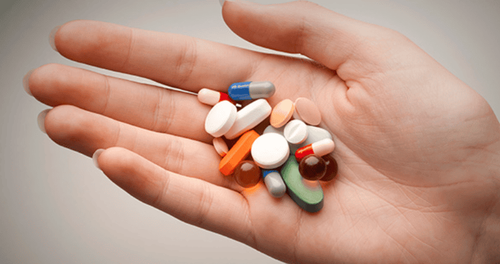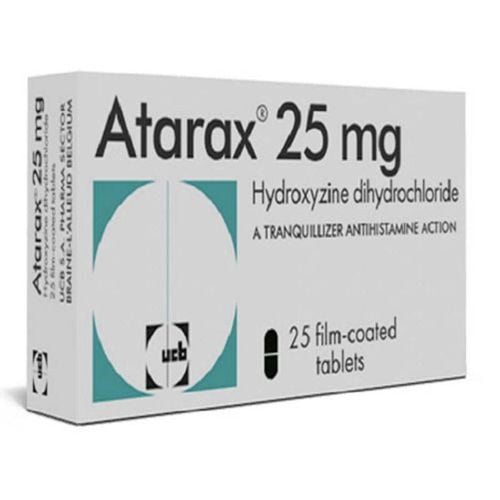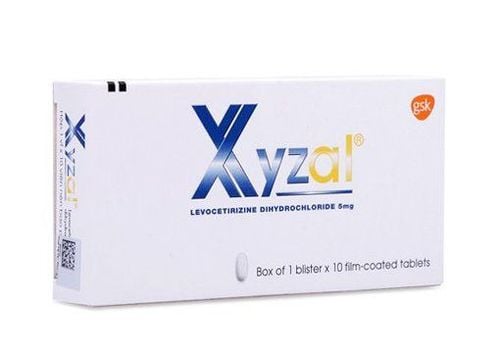This is an automatically translated article.
With the main ingredient is Hydroxyzine, the effect of Atarax 25mg is central nervous system inhibition, antispasmodic, local anesthetic. Hydroxyzine also has an antihistamine effect, so Atarax is also an allergy medicine.
1. What is Atarax?
Atarax belongs to the group of antiallergic and antihistamine drugs, with the main ingredient being Hydroxyzine. Hydroxyzine has antihistamine, central nervous system depressant, anticholinergic, antispasmodic and local anesthetic effects. In addition, Hydroxyzine has antiemetic, calming and sedative effects.
Atarax is prepared in many different forms and strengths such as 25mg and 100mg film-coated tablets, oral syrup packed in 200ml bottles, 100mg/2ml intramuscular or intravenous solution.
Atarax allergy medicine is indicated in the following cases:
Relief of symptoms, manifestations of mild anxiety. Used orally in general anesthesia or parenteral in functional or radiological investigations with pain, pre-anesthesia. Treatment of allergic symptoms of vasomotor rhinitis (seasonal or not), atopic or contact dermatitis, urticaria, conjunctivitis.
2. How is Atarax allergy medicine used?
Depending on the dosage form, usage and dosage of Atarax will be different and also according to the doctor's prescription.
Dosage of Atarax allergy tablets depends on specific needs as follows:
General: 50 - 100mg/day. Relieve symptoms of anxiety and stress: 100-300mg/day. Anesthesia: 100-200mg/day. Allergic or contact dermatitis: 50-100mg/day. Children 30 months - 15 years old: 1 mg/kg body weight/day. Note, not to use Atarax 100mg tablets for children because it is not suitable. Dosage of Atarax allergy medicine syrup is as follows:
Adults: 1 - 4 tablespoons/day (equivalent to 30 - 120mg/day). Children: 1mg/kg body weight/day. The specific dose of Atarax allergy injection is as follows:
Adults: Intramuscular 1 - 3 ampoules/day. Intravenous injection only after mixing with 10ml of physiological serum. Children: Intramuscular 1mg/kg body weight/day, not intravenously. An overdose of Atarax allergy medicine can cause symptoms such as hypotension, convulsions, lethargy. At this point, the patient needs to be induced vomiting or gastric lavage to remove the drug. Because there is no specific treatment, if convulsions, coma, or loss of vomiting reflex occur, gastric lavage and endotracheal intubation can be applied to aspirate gastric juices. . Infusion of fluids and noradrenaline or metaraminol if the patient is hypotensive.
3. Side effects of Atarax allergy medicine
Atarax allergy medicine can cause some unwanted side effects with the frequency of occurrence as follows:
Very common and common: Fatigue, headache, drowsiness (mild to moderate severity), dizziness, restlessness; pharyngitis, thick secretions in the bronchi; abdominal pain, nausea, diarrhea, dry mouth, appetite, weight gain; athritis. Uncommon: Hypotension, palpitations; insomnia, lethargy, irritability, depression; nosebleeds, bronchospasm; urinary retention; Hepatitis; tremor, muscle pain; blurred vision, paresthesia; angioedema, rash, photosensitivity. If you notice any unusual symptoms after taking Atarax allergy medicine, the patient or a patient's family member should report or contact a doctor or pharmacist immediately.
4. Some notes when using Atarax allergy medicine
Do not use Atarax allergy medicine in people who are allergic to the drug's ingredients, have difficulty urinating, glaucoma, who are at risk of angle glaucoma and urinary retention due to prostate or urethral disorders. During the course of taking the drug, do not drink alcoholic beverages. Atarax allergy medicine is a prescription drug, so it should be prescribed and guided by a doctor. Before taking any medication, tell your doctor about your medical history and any other treatments you're taking. The effect of Atarax 25mg drug can be drowsiness, so it is necessary to limit activities such as driving or operating or operating machinery. Pregnant and lactating women should not take the drug because of limited safety data in this population. For intravenous allergy drug Atarax, before injection, it is necessary to dilute the ampoule with 10mg of physiological serum. During injection, about 1ml of blood should be drawn and injected slowly. Note, only intravenous injection to limit hemolysis, not intravenous injection. Atarax allergy medicine may enhance the effect when used with drugs that depress the central nervous system such as analgesics, opiates, barbiturates, anesthetics/anesthetics. In case of concomitant use, the dose of CNS depressants should be reduced to avoid excessive sedation. Atarax allergy medicine may interact with other anticholinergics and increase the anticholinergic effect; inhibits and reverses the effects of adrenaline. Therefore, when the patient is taking Atarax, if a vasoconstrictor is required, noradrenalin or metaraminol should be used. The action of Atarax medicine 25mg is to relieve symptoms, mild anxiety manifestations, anesthesia and treatment of some allergic conditions. To ensure the effectiveness of treatment and avoid unwanted side effects, patients need to strictly follow the instructions of the doctor, professional pharmacist.
Follow Vinmec International General Hospital website to get more health, nutrition and beauty information to protect the health of yourself and your loved ones in your family.
Please dial HOTLINE for more information or register for an appointment HERE. Download MyVinmec app to make appointments faster and to manage your bookings easily.













